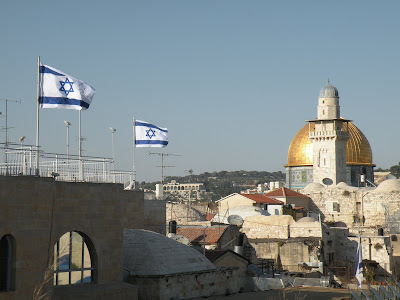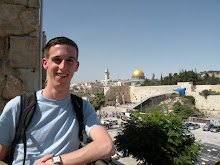Six religions fight over the space where Christ was crucified, died, and rose again: Catholics, Armenian Orthodox, Greek Orthodox, Syrian Orthodox, Coptic Orthodox, and Ethiopian Orthodox. But guess who owns the church? The Muslims. That's the Middle East for you. After watching the Greek Orthodox clergy lock the door from the inside and the Muslims lock the door from the outside (after all, they own the place), he escorted our group of 12 into the Armenian Orthodox recession room. There we spent an hour and a half talking with him about his experience in the church, and then of course some theology. The essential divide between Protestants and the Orthodox Church is that Protestants believe that the Holy Spirit proceeds (originates) from both the Father and the Son. In contrast, the Orthodox believe that Spirit proceeds only from the Father. The original Nicene Creed only states that the Spirit proceeds from the Father, but leaves out "and from the Son." However, the Catholic church (the Protestant church had not been formed at that point) later added "and from the Son" (in Latin, "filioque") to the Nicene Creed. This (along with many other complicated reasons) lead to an eventual East-West schism in 1054. All this to say that 1,000 years later sitting in the Church of the Holy Sepulcher, we are still discussing this. When clarifying our doctrine for Father Samuel (though he certainly already knew it!), I pointed out that as Protestants, we say the filioque as a part of the Nicene Creed (i.e. we affirm and say in our creed that the Spirit proceeds from the Son, as well). He quickly responded, "Then you are not saying the Nicene Creed! Why do you destroy the Nicene Creed?! The filioque was added later and is not true!"
All this to say that Father Samuel is actually one of the sweetest, most accommodating, and kind men I have ever met in my life. We simply agreed to disagree. He even let us pull his perfectly formed white beard! I felt like a child on Santa's lap. :-) He then, of course, showed us the site of Golgotha, the tomb, and all the other places in the church. Very unique and mind-blowing experience. The three major religions in the church, Catholicism, Greek Orthodox, and Armenian Orthodox, fight over literally every square inch of the space. It was amazing to hear Father Samuel speak of how he wouldn't even want to let the Catholics clean his space because then they might claim the space for their own. Every oil lamp, every painting, every chapel, every stone - literally down to the inch - was carefully claimed by a group.
What a thought: the spot where the greatest act of love was shown is now a spot of discord, of conflict, of schism. It saddens Father Samuel, and it saddens me, but what are we to do?
What love is this?
Pictures are coming soon of that experience!

Today we visited a Samaritan village at the top of Mt. Garazin called Shechem. It's not a huge tourist destination, so in this picture, some children are excited to see the big charter bus full of Americans roll through their quiet neighborhood. Mt. Garazin is the place where Joshua "ratified" the blessings to the people of Israel in Deuteronomy 28:1-14.
A girl in our group read these verses loudly as we were standing at the top of the mountain. It was an incredible time of envisioning Joshua speaking these words over the people of Israel. Across the valley is Mount Ebal, where Deut. 28:15-68, the curses, were read. Today, the Arabic town of Nablus sits at the bottom of the valley in between the two mountains. They even shoot up to the mountain at the Samaritans sometimes in rage that the Samaritans are "looking down" on them. No worries, though, we were very safe. :-)

This is a minaret, the tower on a mosque, in an Arabic town. Minarets look very similar all across Israel. Even the one on Temple Mount (where Dome of the Rock is) looks a lot like this one! You can see the speakers that are used for the daily calls to prayer, and the crescent moon (Islamic symbol) on top.

Jacob's Well in Shechem (Nablus), where Jesus meeting the Samaritan woman at the well is remembered in John 4. This is most likely the actual spot where the woman at the well event happened. John 4:13-14 was given new meaning as I stood at the temporal spring that Jesus used as an example for his interaction with the woman. As I drank the well water, I was reminded that this well provides me with earthly sustenance. Christ provides me with a spring of water that "wells up into eternal life." Praise be to Him.
Jesus answered, "Everyone who drinks this water will be thirsty again, but whoever drinks the water I give him will never thirst. Indeed, the water I give him will become in him a spring of water welling up to eternal life."
I am exhausted, but I press on: learning, trekking, laughing, growing. Praise be to the Lord.
In Christ.

















